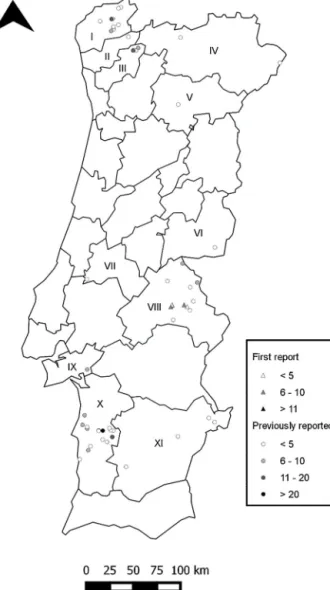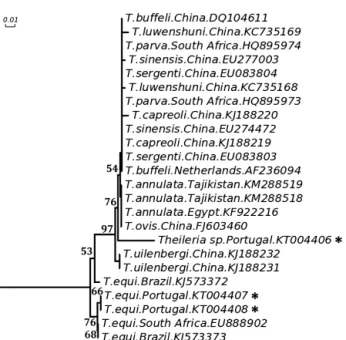ContentslistsavailableatScienceDirect
Ticks
and
Tick-borne
Diseases
jo u r n al hom ep a g e :ww w . e l s e v i e r . c o m / l o c a t e / t t b d i s
Short
communication
Detection
and
phylogenetic
characterization
of
Theileria
spp.
and
Anaplasma
marginale
in
Rhipicephalus
bursa
in
Portugal
Joana
Ferrolho
a,
Sandra
Antunes
a,
Ana
S.
Santos
b,
Rita
Velez
b,
Ludovina
Padre
c,
Alejandro
Cabezas-Cruz
d,
Maria
Margarida
Santos-Silva
b,
Ana
Domingos
a,∗aInstitutodeHigieneeMedicinaTropical–GlobalHealthandTropicalMedicine,RuadaJunqueira100,1349-008Lisboa,Portugal
bCentrodeEstudosdeVetoreseDoenc¸asInfeciosasDr.FranciscoCambournac,InstitutoNacionaldeSaúdeDr.RicardoJorgeI.P.,ÁguasdeMoura,Portugal
cUniversidadedeÉvora,Évora,Portugal
dCenterforInfectionandImmunityofLille(CIIL),INSERMU1019–CNRSUMR8204,UniversitédeLille,InstitutPasteurdeLille,1rueProfesseurCalmette,
59019LilleCedex,France
a
r
t
i
c
l
e
i
n
f
o
Articlehistory:
Received25August2015
Receivedinrevisedform9December2015
Accepted10January2016 Availableonlinexxx Keywords: Rhipicephalusbursa Tick-bornepathogens Theileriaannulata Theileriaequi Anaplasmamarginale Portugal
a
b
s
t
r
a
c
t
Ticksareobligatoryblood-suckingarthropod(Acari:Ixodida)ectoparasitesofdomesticandwildanimals
aswellashumans.Theincidenceoftick-bornediseasesisrisingworldwide,challengingourapproach
towarddiagnosis,treatmentandcontroloptions.RhipicephalusbursaCanestriniandFanzago,1877,a
two-hosttickwidelydistributedinthePalearcticMediterraneanregion,isconsideredamulti-hosttick
thatcanbecommonlyfoundonsheep,goatsandcattle,andoccasionallyonhorses,dogs,deerand
humans.R.bursaisaspeciesinvolvedinthetransmissionofseveraltick-bornepathogenswithaknown
impactonanimalhealthandproduction.TheaimofthisstudywastoestimateR.bursaprevalencein
PortugalMainlandandcirculatingpathogensinordertocontributetoabetterknowledgeoftheimpactof
thistickspecies.AnaplasmamarginaleandTheileriaspp.weredetectedandclassifiedusingphylogenetic
analysis.ThisisthefirstreportofTheileriaannulataandTheileriaequidetectioninR.bursaticksfeedingon
cattleandhorses,respectively,inPortugal.Thisstudycontributestowardtheidentificationofcurrently
circulatingpathogensinthistickspeciesasaprerequisitefordevelopingfutureeffectiveanti-tickcontrol
measures.
©2016PublishedbyElsevierGmbH.
1. Introduction
Duringthelasttwodecades,agrowinginterestintick-borne diseasesfromveterinary,medical,andpublichealthperspectives has emerged (Jongejan and Uilenberg, 2004). The worldwide prevalenceofthesediseasesissteadilyrising,challenginghowwe approachdiagnosis,treatmentandpreventativecontrolmeasures, andunderliningtheimportanceoftheOneHealthconcept(
Dantas-Torresetal.,2012).Ticksareknowntohaveasignificantimpact
onhostspeciesthroughtheirfeedingbehavior,causingdirectskin and sub-cutaneous tissue damage and blood depletion, whilst actingasvectorsofdifferentpathogens,suchasviruses,bacteria,
∗ Correspondingauthor.
E-mailaddresses:joana.ferrolho@ihmt.unl.pt
(J.Ferrolho),santunes@ihmt.unl.pt(S.Antunes),asps@vodafone.pt(A.S.Santos),
ritavlz@yahoo.co.uk(R.Velez),lpadre@ue.pt(L.Padre),
cabezasalejandrocruz@gmail.com(A.Cabezas-Cruz),
m.santos.silva@insa.min-saude.pt(M.M.Santos-Silva),adomingos@ihmt.unl.pt
(A.Domingos).
protozoa or fungi (Bell-Sakyi et al., 2007; Colebrook and Wall, 2004).Itisestimatedthatapproximately10%oftickspeciesexert anactiveroleasbiologicalvectorsinthetransmissionoftick-borne pathogens,includingseveralzoonoticagents(Heymanetal.,2010;
JongejanandUilenberg,2004;LabudaandNuttall,2004).Amongst
thesetickspeciesisRhipicephalusbursaCanestrini andFanzago, 1877, classified in the Ixodidae family (Walker et al., 2000). Epidemiologicalstudieshave identifiedR.bursaasbeingwidely distributedintheMediterraneanregionwheretheclimateis typi-callycharacterizedbylongdrysummersandcoldwinters(Walker
etal.,2000;Yeruhametal.,1985).Consideredamulti-hosttick,
theprimaryhostsofthisspeciesincludecattle,sheep,andgoats
(Santos-Silvaetal.,2011;Walkeretal.,2000).Thoughless
com-mon,thistickcanalsobefoundinotherdomesticanimals,aswell asinwildungulatesandsmall-mediumsizedmammalsand spo-radically,inhumans(delaFuenteetal.,2004b;Mihalcaetal.,2012;
Psaroulakietal.,2006;Santos-Silvaetal.,2011;Sattaetal.,2011;
Walkeretal.,2000).R.bursahasbeendescribedasbeinginvolved
inthetransmissionofagentsofthegenusAnaplasma(delaFuente
etal., 2004a),Babesia(Altayetal., 2008;M’Ghirbietal.,2010),
http://dx.doi.org/10.1016/j.ttbdis.2016.01.004
Theileria(Garcia-Sanmartinet al.,2008), Rickettsia(Boudebouch
etal.,2009;deSousaetal.,2006;Ioannouetal.,2011;Toledoetal.,
2009)amongothers,withaknownimpactonanimalhealth.The mainobjectiveofthisstudywastoprovideup-datedinformation regardingthecurrentlycirculatingpathogensinR.bursaandtheir phylogeneticcharacterization,inPortugalMainland,forthefuture developmentandplanningofeffectivetickcontrolmeasures.
2. Materialsandmethods
2.1. Tickssamples
Atotalof266R.bursatickswereincludedinthisstudy.Ticks werecollectedfrom2007to2014in24localadministrativeunits– municipalities(LAUI)belongingto11outofthe28Mainland Por-tuguesesubregions(NomenclatureofTerritorialUnitsforStatistics regions–NUTSIII),includingtheintermunicipalcommunity(IMC) ofMinho-Lima,IMCCávado,IMCAve,AltoTrás-os-Montes,IMC Douro,Beira InteriorSul,IMC MédioTejo, AltoAlentejo, Penin-suladeSetúbal,IMCAlentejoLitoralandIMCBaixoAlentejo.Fig.1
showsthenumberofR.bursaspecimenscollectedandthe loca-tions,accordingtogeographicalcoordinatesandsubregions(QGIS 2.4.0. Chugiak). Ticks wereeither removed from domestic ani-malsbylocalveterinariansorcollectedbyflagging/draggingthe vegetationandfurtheridentifiedtospecieslevelusing morpho-logical keys,as previously described (Santos-Silva et al., 2011). Afteridentification, ticks werepreserved in 70% alcohol, sepa-ratedaccordingtoinstars,originandsiteofcollection,untilfurther manipulation.
2.2. DNAextraction,PCRscreeningandampliconsequencing Each tick was recovered from ethanol, rinsed in pH 7.4 phosphate-bufferedsaline(PBS),homogenizedandusedforDNA extractionusingTriReagent(Sigma–Aldrich,Lisbon,Portugal),as previously described (Antunes etal., 2015).DNA concentration andpuritywasaccessedbyspectrophotometry(ThermoScientific NanoDrop2000,Lisbon,Portugal).DNAwasstoredat−20◦Cfor
downstreamapplication.
AninitialscreeningtovalidateDNAextractionwasperformed inagroupofsamplesrandomlyselected,representing20%ofall extractedticks.UsingtheprimerpairT1B/T2Athattargetsa360bp fragmentoftickmitochondrial12SrDNA,aPCRwasperformedas previouslydescribed(BeatiandKeirans,2001).
Toamplify Anaplasma spp. and Ehrlichia spp. a broad range PCRscreenwiththeprimersEHR16sD/EHR16sRwasconducted asreportedbefore(Inokumaetal.,2000).Thisprimerset ampli-fiesa345bpfragmentofthe16SrRNAgeneofbacteriawithinthe familyAnaplasmataceae,includingthegeneraAnaplasma,Ehrlichia, Neorickettsia,and Wolbachia. For piroplasms, a PCR targeting a 408bpfragmentfromthesmallsubunitof18SrDNAofBabesiaspp. andTheileriaspp.wasconductedusingtheprimersetPiro-Aand Piro-Basdescribedelsewhere(Harrusetal.,2011).Todetect Cox-iellaburnetiiDNA,anested-touchdownPCRwasdoneusingthe primerpairsTrans1/2followedbyTrans3/4thatamplifya243bp fragmentoftherepetitiveinsertionelementIS1111(Lorenzetal., 1998).PrimerswereobtainedfromStabVida(Lisbon,Portugal).PCR wereperformedin25lreactionswithSupremeNZYTaq2×Green MasterMix(NZYTech,Lisbon,Portugal),1Mprimersandupto 5loftemplateDNA.Nuclease-freewaterwasusedasnegative control.Aspositivecontrols,DNAextractedfromreferencestrains was used: Anaplasma marginale Va-48 strain, Babesia bigemina Israelstrain,C.burnetiiNineMilestrain(Vircell,Spain)andTheileria annulata(Uzbekstrain).AmplificationswereperformedinaT100 thermalcycler(Biorad,Amadora,Portugal)accordingtoreferences
Fig.1. GeographicallocationsandnumberofRhipicephalusbursafoundaccordingto
NUTSIIISubregions.MapwasperformedusingtheQGIS2.4.0.Chugiakprogram.
Cir-cles–Correspondstotheexactcoordinatesofcollectionsitesinpreviouslyreported
municipalities;Triangles–Correspondstotheexactcoordinatesofcollectionsites
innewmunicipalities;I–Intermunicipalcommunity(IMC)ofMinho-Lima,II–IMC
Cávado,III–IMCAve,IV–AltoTrás-os-Montes,V–IMCDouro,VI–BeiraInterior
Sul,VII–IMCMédioTejo,VIII–AltoAlentejo,IX–PeninsuladeSetúbal,X–IMC
AlentejoLitoral,XI–IMCBaixoAlentejo.
(Harrusetal.,2011;Inokumaetal.,2000;Lorenzetal.,1998).
Pos-itiveampliconswerepurifiedusingtheNZYGelpurekit(NZYtech, Lisbon,Portugal)andsentforSangersequencingatStabVida (Lis-bon,Portugal).Theobtainedsequenceswerealigned,comparedto thosealreadydepositedintheNCBInucleotidedatabase(http://
blast.ncbi.nlm.nih.gov/Blast).
2.3. Phylogeneticanalysis
ThephylogeneticanalyseswereconductedwithA.marginale, Anaplasma phagocytophilum, Anaplasma platys, Ehrlichia canis, Ehrlichiachaffeensis,Ehrlichiaewingii,Ehrlichiacanis16SrDNA (fam-ilyAnaplasmataceae)andTheileriaspp.18SrDNA(Apicomplexan) nucleotidesequencesalignedwithMAFFT(v7)configuredforthe highestaccuracy(KatohandStandley,2013).Afteralignment,the sequenceswerecuredusingGblocks(Castresana,2000)withthe followingparameters:minimumlengthofablockaftergap clean-ing:10,nogappositionswereallowedinthefinalalignmentand allsegmentswithcontiguousnonconservedpositionsbiggerthan
Table1
ResultsofPCRscreeningfortick-bornepathogensinRhipicephalusbursafromMainlandPortugal.
Subregions/no municipalitiesa
Noofpositives/testedticksb Sequencing
results
Overall B.taurus C.familiaris C.hircus E.caballus O.aries S.scrofa Vegetation
IMCMinho-Lima 4 33 – – – – – – 15m;18f
IMCCávado 1 3 3m – – – – – –
IMCAve 1 2/23 – – – 2/9m;14f – – – 2T.equi
AltoTrás-os-Montes 2 6 3m;2f 1m – – – – –
IMCDouro 1 3 – 3f – – – – –
BeiraInteriorSul 1 1/4 – – – – 1/4f – – 1A.marginale
IMCMédioTejo 1 1 – – – – – – 1m
PeninsuladeSetúbal 1 2/6 – – – – – – 3m;2/3f 1A.marginale
AltoAlentejo 7 1/61 1f;43n;3l – 3m;1/7f 1m;1f;1n – 1n – 1A.marginale
IMCAlentejoLitoral 2 4/120 2/65m;2/49f 2m;3f – – 1m – – 3cA.marginale;
1T.annulata
IMCBaixoAlentejo 3 6 3f – – – 3f – –
Total 24 10/266 2/71m;2/55f; 43n;3l 3m;6f 3m;1/7f 10males, 15females, 1nymph 1m;1/7f 1n 19m;2/21f
aPortugueseMainlandaccordingtoNomenclatureofTerritorialUnitsforStatisticsregions–NUTSIIIandlocaladministrativeunitsormunicipalities(LAUI).
bAccordingtotickinstars:m-male;f-female;n-nymph;l-larva.
c OnemaleandtwofemaleswithAnaplasmamarginale.
4wererejected.Twophylogenetictreeswerebuilt,onefor mem-bersofAnaplasmataceaeandtheotherforApicomplexanparasites. Phylogenetictreeswerereconstructedusingneighborjoining(NJ) based on Kimura 2-parameters genetic distances. Phylogenetic inference and model selection were performed using MEGA 6
(Tamuraetal.,2013).Thereliabilityfortheinternalbranchesof
NJwasassessedusingthebootstrappingmethod(1000bootstrap replicates).Graphicalrepresentationandeditingofthe phyloge-netictreeswereperformedwithEvolView(Zhangetal.,2012).The accessionnumbersandgeographicoriginsoftheisolatesusedin thephylogeneticanalysisareshowninthephylogenetictrees.The sequencesobtainedinthisstudyweresubmittedtoGenBankand identifiedwiththerespectiveaccessionnumber.
3. Results
Fromthe266R.bursastudied,226werefoundfeedingon ani-mals(88males,90females,45nymphsand3larvae)and40were questingticks(19malesand21females).Aspreviouslymentioned, ticks wereobtained from 24 municipalities that correspondto 11PortugueseMainland subregions(NUTSIII).Fig.1showsthe numberandgeographicallocationofR.bursaaccordingtothose subregions.MostofthetickswereobtainedfromAlentejoLitoral (45.1%),followedbyAltoAlentejo(22.9%),Minho-Lima(12.4%)and Ave(8.6%).Asmallernumberoftickswerefoundintheremaining subregions,rangingfrom2.3to0.4%(Table1).Ofnoteisthefact thattwoofthesevenmunicipalitiesfromAltoAlentejorepresent newdatarecordsforcurrentR.bursadistribution(AlterdoChão andCrato)astheoccurrenceofthistickspecieswasnotpreviously reportedinthoseplaces(Fig.1).Regardingseasonality,adultswere mostlyfoundduringspringandsummermonths,contrastingwith immaturesthatwereobtainedfromfalltowinter.Considering tick-hostassociations,R.bursawereremovedfromcattle(Bostaurus; N=172),followedbyhorses(Equuscaballus;N=26),goats(Capra hircus;N=10),sheep(Ovisaries;N=8),dogs(Canisfamiliaris;N=9) andpigs(Susscrofa;N=1)(Table1).Tickswereobservedinbody locationsasvariedasthehead,namelyintheinnersurfaceofthe ears;abdominalarea,includingscrotumandudder;perineum,tail andlimbs.
PCRscreeningforthepresenceoftick-bornepathogensrevealed an overall prevalenceof infection in R. bursaof approximately 3.8%(10/266). Seventicks(2.6%) werepositive for 16SrDNAof Anaplasma/Ehrlichiaspp. and three were positive for 18S rDNA
subunitofBabesia/Theileriaspp.(1.1%).Ampliconsequencing con-firmedthepresenceofA.marginale,T.annulataandTheileriaequiin R.bursaticks.A.marginaleinfectedtickswereobtainedfrom cat-tle(N=3,1maleand2females),sheep(N=1,female),goat(N=1, female),andvegetation(N=2,females),inthefoursubregionsIMC AlentejoLitoral,BeiraInteriorSul,AltoAlentejoandPeninsulade Setúbal,respectively.T.annulatawasfoundinonemalefeedingin cattlefromIMCAlentejoLitoral;whereasT.equiintwomales feed-inginhorsesfromIMCAve.NoC.burnetiiDNAwasdetectednor thepresenceofco-infections.
Phylogenetic analysis using 16S rDNA from different world-wideisolatesofA.marginaleandotherpathogenscloselyrelated asA.platys,A.phagocytophilum,E.canis,Ehrlichiaruminantium,E. ewingii and E.chaffeensisconfirmedinfection withA. marginale (Fig.2).Blastanalysisshowedthat thefoursequencesobtained bothfromquestingandcattleparasitizingticks(withthe acces-sionno.A.marginalePortugalKT004409,KT004411andKT004412 inFig.2)presentedbetween98and100%identifytothebovine strainKNP/M8/a (labeledasA.marginale SouthAfricaaccession no.KC189852inFig.2).Theremainingsequencesfromticks col-lectedfromsmallruminantsandvegetation(withtheaccession no.A.marginalePortugalKT004414,KT004410andlabeledasA. marginalePortugal.2inFig.2)presentedbetween97and99% iden-tifytothecloneLuzon(labeledasA.marginalePhilippinesaccession no.LC007100inFig.2).ThetwosequencesfromT.equidetectedin aninfectedhorse(withtheaccessionno.T.equiPortugalKT004407 andKT004408inFig.3)clusteredtogetherwithT.equiisolatesfrom BrazilandSouthAfrica.Finally,anisolatedlabeledasTheileriasp. PortugalKT004406(Fig.3)didnotshowclearphylogenetic rela-tionshipwithanyoftheTheileria spp.usedinthephylogenetic analysis.However,thisisolateshowed96%similaritytoasequence detectedin Hyalommaanatolicum fromTajikistan(labeled asT. annulataTajikistanaccessionno.KM288519inFig.3).
4. Discussion
R.bursaiswidelydistributedacrosstheMediterraneanregion, includingPortugal. InPortugal thepresenceof this tickspecies wasfirstrecognizedin1943byAboim-Inglês(Tendeiro,1963),and subsequentlyreportedinseveralareasandondifferentvertebrate hosts(deSousaetal.,2011;Santos-Silvaetal.,2011,2012,2014).In thepresentstudy,R.bursawerecollectedfromsixspeciesof domes-ticanimals(B.taurus,E.caballus,C.hircus,O.aries,C.familiarisand
Fig.2.PhylogenetictreeofAnaplasmataceaeusing16SribosomalRNAgene sequences.TheevolutionaryhistorywasinferredbyusingtheNJmethodbased
ontheKimura2-parametermodel.16SrDNAgenenucleotidesequencesfromA.
marginale,A.phagocytophilum,A.platys,E.canis,E.chaffeensis,E.ewingii,E.canis
(familyAnaplasmataceae)wereused.Accessionnumbersofsequencesareshown
andisolatesfromPortugalreportedinthisstudyaremarkedwith“*”.Numeralson
branchesarebootstrapvalues(1000replicates).R.prowazekiiwasusedasoutgroup
toAnaplasmataceae.Anaccessionno.wasnotattributedtotheisolateA.marginale.
Portugal.2duetotheshortsizeofthesequence.
Fig.3. PhylogenetictreeofTheileriausing18SribosomalRNAgenesequences.
TheevolutionaryhistorywasinferredbyusingtheNJmethodbasedontheKimura
2-parametermodel.18SrDNAgenenucleotidesequencesfromT.buffeli,T.equi,T.
annulata,T.parva,T.ovis,T.capreoli,T.luwenshuni,T.sinensis,T.sergenti,T.
uilen-bergi(OrderPiroplasmida)wereused.Accessionnumbersofsequencesareshown
andisolatesfromPortugalreportedinthisstudyaremarkedwith“*”.Numeralson
branchesarebootstrapvalues(1000replicates).Babesiaoviswasusedasoutgroup
toTheileria.
S.scrofa),allpreviouslyincludedinthelistofhostsparasitizedby thistickspecies.Moreover,thisreportalsoconfirmstheoccurrence ofR.bursain22outofthe68priorrecordedmunicipalities,from atotalof278Mainland LAU(deSousaetal.,2011;Santos-Silva
etal.,2011,2012,2014).Newdataongeographicaldistribution
includestheidentificationofthisspeciesintwoadditional munic-ipalitiesfromthesubregionofAltoAlentejo.Interestingly,thisis alsothefirstreportofR.bursalarvaedetectioninPortugal.The threelarvae werecollectedfromcattlefromAltoAlentejo; and togetherwithagroupof45nymphs,reinforcestheassociationof theimmatureinstarstoungulates,asdiscussedinpreviousstudies
(Santos-Silvaetal.,2011).ThepresenteddatashowsthatR.bursais
activeduringallyear,withamarkedseasonalbehavioraccording tothedevelopmentalstage,withadultsbeingpresentmostly dur-ingthespring-summermonths(MaytoSeptember)andimmature inautumn-winter(OctobertoJanuary–February).Thisisin agree-mentwiththefindingsofotherstudies,althoughthemajorityof theavailabledatareferstoadultticks(deSousaetal.,2011;
Santos-Silvaetal.,2011,2012,2014).Althoughthehighestnumbersof
tickswerecollectedinthesummer(75.2%),thismightreflectnot onlyspeciesseasonaltendencybutalsothetickactivesurveillance duringcattlevaccinationcampaignsandotherlivestock manage-ment.FewsurveysconductedinPortugalhavefoundnymphsofR. bursa,andallspecimenswereobtainedoncattle,goats,sheepand
mice(Santos-Silvaetal.,2011).Nevertheless,thereduced
num-berofreportsregardingimmaturesislikelytobeduetoalimited screeningof ungulates duringcoldermonths.During ourstudy wehave foundanequivalentratioof male:female. Althougha similarratioofmale:femalehasbeenreported(Garcia-Sanmartin etal.,2008),moststudiesreportthatthenumberofmales gener-allyoutnumbersthenumberoffemales(Moshaveriniaetal.,2012;
Papadopoulosetal.,1996;Yeruhametal.,1996).Asmentioned,the
primaryhostsofthistickspeciesincludecattle,sheep,andgoats; andlessfrequentlydogsandsmallermammals,suchasrabbits(de
laFuenteetal.,2004a;Masalaetal.,2012;Mihalcaetal.,2012;
Psaroulakietal.,2006;Santos-Silvaetal.,2011;Sattaetal.,2011;
Walkeretal.,2000).Here,R.bursatickswereremovedmainlyfrom
largemammalssuchascattleandhorses;andinlessernumbers fromgoats,sheep,anddogs.Thisresultmaybelinkedtothefact thatthepresentsurveywasnotdesignedtocompareR.bursahost preference,buttoprimarilycontributetoabroaderinsightonthe tickR.bursadistribution.Nevertheless,ourresultsarevery simi-lartotheonesdescribedinastudyconductedinSardinia(Satta etal.,2011).Additionally,R.bursaisdescribedtohavepreference forparticularareasofthehostbody,accordingtotickinstarsand thehostspecies(Estrada-Penaetal.,2004;Yeruhametal.,1989). Indeed,inthisstudydistinctlocationswererecordedalthoughthe reducednumberofcollectedtickslimitsanystatisticalinference. Incattle,thehighestnumberofadulttickswascollectedfromthe abdominalandperinealareas,contrastingwiththeimmaturesthat weremainlyfoundontheheadanddorsalregions.Thesame obser-vationswererecordedbyotherauthors(Estrada-Penaetal.,2004;
Feldman-Muhsam,1953;Papadopoulosetal.,1996).More
specifi-cally,inhorsesandgoatsmostoftheadultR.bursawerecollected fromtheposteriorregionsofthebody,includingperineumand tailandperineumandudder,respectively;insheepanddogs,ticks werefoundmostlyonthehead,mainlyfromtheinnersurfaceof theears,similarlytowhathavebeenreportedelsewhere(
Feldman-Muhsam,1953; Papadopoulosetal., 1996).No specimenswere
foundonotherlocationsalreadydescribedforthesehosts,suchas thetail,perianalandinguinalareas,interdigitalspacesandaxilla, forsheep(Moshaveriniaetal.,2012;Papadopoulosetal.,1996;
Yeruhametal.,1989);andneck,breastandtheinterdigitalspaces,
fordogs(Papadopoulosetal.,1996).
Molecularresultsconfirmed thepresence of A. marginale, T. annulataandT. equiinR.bursaticks.A.marginale wasfoundin
ticksfeedingincattle,sheep,andgoats,andamongquestingticks. T.annulatawasfoundinatickfeedingincattle;andT.equiinticks feedinginhorses.Despitethedetectionofthesethreepathogens, itwasnotpossibletoconcludeaboutthevectorcapacityofthis tickspecies.Toaddressthisonewouldneedmoreevidence,firstly becausethebiologicmaterialwasobtainedfromthecompletetick andthepathogencouldbepresentonlyinthemidgutandnotin thesalivaryglandsfromwhereitwouldbetransmittedviasaliva; secondly,apositivePCRdoesnotconfirmthatthesepathogensare capableofmultiplicationinthistickandthustransmitted. Addi-tionally,oncethebloodofeachanimalwasnottestedtheoriginof eachpathogenwasnotdetermined.Twopossiblesourcesoftick infectioncouldbeimplicated: theblood mealonthehostfrom wherethetickwascollected,orthebloodmealfromtheprevious hostthroughtransstadialtransmission.
InPortugalandSpain,R.bursaisaprovenvectorofA.marginale andtheinfectionofcattle,knownasbovineanaplasmosis,caused bythispathogenhasbeenalreadyreported(Caeiro,1999;dela
Fuenteetal.,2004a;Kocanetal.,2004).Bovineanaplasmosisis
now known to beendemic in tropical and subtropical regions worldwide,causingsubstantialeconomiclossestocattleindustries
(Kocanetal.,2003).T.annulataismainlytransmittedbyticksof
thegenusHyalomma;however,similarlytoourstudy,R.bursawas alsoassociatedwiththetransmissionofthispathogeninTunisia
(M’Ghirbietal.,2010).Incattle,T.annulataisthecausativeagentof
tropicaltheileriosisresponsibleforseriousconstraintsonthe ani-malhealthandproductivityworldwideduetohighmorbidityand mortality(Brancoetal.,2010;Doliveiraetal.,1995).InPortugal, thepresenceofthistick-bornepathogenhasalreadybeenreported incattleduringanacutelethalinfectionofcalveshighlyinfested byticksofthegenusHyalomma(Brancoetal.,2010),andduring asurveyconductedinasymptomaticcattlefordetectionof piro-plasms(Gomeset al.,2013).Nevertheless, wewerenotableto identifyanystudyconductedinPortugalthathasisolatedT. annu-latafromR.bursaticks.T.equi(formerlyknownasBabesiaequi) canbenaturallytransmittedbyticksofthefamilyIxodidae(Stiller etal.,2002)andR.bursahasbeenimplicatedasthevectorof piro-plasmosiscausedbyT.equiinhorsesinSpainandIran(Abedietal.,
2014;Garcia-Sanmartinetal.,2008).Similarly,wehavefoundT.
equiinticksofthisspeciesinfestinghorses.Previousstudies con-ductedinPortugalreportthedetectionofthispathogeninsamples collectedfromhorses(Baptista etal.,2013;Ribeiroetal.,2013) but,todate,noreportswerefoundrelatingR.bursawithT.equi inourcountry. Equinepiroplasmosisisendemicinthenorthof Portugal(Ribeiroetal.,2013)anditisestimatedthat90%ofthe equinepopulationworldwidelivesinareaswhereequine piroplas-mosisispresent(Dewaal,1992).Nowadays,equinepiroplasmosis hasseriousimplicationsforincreasinginternationaltradeofhorses
(Ros-Garciaetal.,2013).Tothebestofourknowledge,ourreport
isthefirsttoidentifyT.annulataandT.equiinR.bursaticksfeeding indomesticcattleandhorses,respectively,inPortugal.
5. Conclusions
Ticksandtick-bornediseasesareacurrentandemergingglobal threatforhumanandanimalspecies.Theimpactofglobalclimate change, human activities, including land management, habitat destructionandcontrolstrategiesthatrelyontheuseofpesticides, might beresponsible for a changein tick biology and possibly contributetotherapidannualriseinthetickpopulation(Heyman
etal.,2010;Omeragic,2011;Santos-Silvaetal.,2011).Theresults
ofthisstudyindicatethatinPortugal,R.bursacanbefoundonhosts suchascattle,smallerruminants,suchassheepandgoats,horses, andoccasionallydogs.Also,thistickisactiveduringallyear,with amarkedseasonalbehavioraccordingtothedevelopmentalstage. Ourstudyalsodemonstrates thatseveralpathogensresponsible
fortick-bornediseases,particularlyA.marginale,T.annulataandT. equi,doexistinR.bursaticksandcirculateindeterminedareasof Portugal.Moreover,allpositiveticksonlyharboredasingle infec-tion.HerewereportforthefirsttimethedetectionofT.annulata andT.equiamongstR.bursaticksfeedingindomesticcattleand horses,respectively,inPortugal.Theconfirmationofthepresence ofAnaplasmaandTheileriainPortugalisofextremeimportance asbothpathogensexertgreatimpactinanimalhealth, influenc-inganimalproductionandtrading.Finally,informationaboutthe prevalenceofinfectioninticksisessentialtoprovideinformationin ordertodevelopfutureeffectivepreventiveandcontrolstrategies.
Conflictofinterest
Theauthorsdeclarenocompetingpersonalorfinancial inter-ests.
Acknowledgments
TheauthorswouldliketoacknowledgeVardaShkap(Kimron VeterinaryInstitute,Israel)forkindlyprovidingB.bigeminaand T.annulatacontrolsandalsoJosédelaFuente(SaBio,Institutode InvestigaciónenRecursosCinegéticos,Spain)fortheA.marginale control.AspecialacknowledgetoDanielBacellarfor his collab-orationintickcollection.WealsowouldliketorecognizeNuno Domingues(FaculdadedeCiênciasdaUniversidadedeLisboa)for thecontributionontickDNAextractionandAnaBuxo(Instituto SuperiorTécnicodeLisboa)forthehelpwithQGISsoftware.This researchwassupportedbytheprojectsPTDC/CVT-EPI/4339/2012 andPTDC/SAU-SAP/115266/2009,fundedbytheFundac¸ãoparaa CiênciaeTecnologia.
References
Abedi,V.,Razmi,G.,Seifi,H.,Naghibi,A.,2014.Molecularandserologicaldetection
ofTheileriaequiandBabesiacaballiinfectioninhorsesandixodidticksinIran. TicksTick-BorneDis.5,239–244.
Altay,K.,Aktas,M.,Dumanli,N.,2008.DetectionofBabesiaovisbyPCRin
Rhipicephalusbursacollectedfromnaturallyinfestedsheepandgoats.Res.Vet. Sci.85,116–119.
Antunes,S.,Merino,O.,Lerias,J.,Domingues,N.,Mosqueda,J.,delaFuente,J.,
Domingos,A.,2015.ArtificialfeedingofRhipicephalusmicroplusfemaleticks
withanticalreticulinserumdonotinfluencetickandBabesiabigemina acquisition.TicksTick-BorneDis.6,47–55.
Baptista,C.,Lopes,M.S.,Tavares,A.C.,Rojer,H.,Kappmeyer,L.,Mendonca,D.,
Machado,A.D.C.,2013.DiagnosisofTheileriaequiinfectionsinhorsesinthe
AzoresusingcELISAandnestedPCR.TicksTick-BorneDis.4,242–245.
Beati,L.,Keirans,J.E.,2001.Analysisofthesystematicrelationshipsamongticksof
thegeneraRhipicephalusandBoophilus(Acari:Ixodidae)basedonmitochondrial 12SribosomalDNAgenesequencesandmorphologicalcharacters.J.Parasitol. 87,32–48.
Bell-Sakyi,L.,Zweygarth,E.,Blouin,E.F.,Gould,E.A.,Jongejan,F.,2007.Tickcell
lines:toolsfortickandtick-bornediseaseresearch.TrendsParasitol.23, 450–457.
Boudebouch,N.,Sarih,M.,Socolovschi,C.,Amarouch,H.,Hassar,M.,Raoult,D.,
Parola,P.,2009.Molecularsurveyforspottedfevergrouprickettsiaeinticks
fromMorocco.Clin.Microbiol.Infect.15,259–260.
Branco,S.,Orvalho,J.,Leitao,A.,Pereira,I.,Malta,M.,Mariano,I.,Carvalho,T.,
Baptista,R.,Shiels,B.R.,Peleteiro,M.C.,2010.FatalcasesofTheileriaannulata
infectionincalvesinPortugalassociatedwithneoplastic-likelymphoidcell proliferation.J.Vet.Sci.11,27–34.
Caeiro,V.,1999.GeneralreviewoftickspeciespresentinPortugal.Parassitologia
41(Suppl1),11–15.
Castresana,J.,2000.Selectionofconservedblocksfrommultiplealignmentsfor
theiruseinphylogeneticanalysis.Mol.Biol.Evol.17,540–552.
Colebrook,E.,Wall,R.,2004.EctoparasitesoflivestockinEuropeandthe
Mediterraneanregion.Vet.Parasitol.120,251–274.
Dantas-Torres,F.,Chomel,B.B.,Otranto,D.,2012.Ticksandtick-bornediseases:a
OneHealthperspective.TrendsParasitol.28,437–446.
delaFuente,J.,Naranjo,V.,Ruiz-Fons,F.,Vicente,J.,Estrada-Pena,A.,Almazan,C.,
Kocan,K.M.,Martin,M.P.,Gortazar,C.,2004a.Prevalenceoftick-borne
pathogensinixodidticks(Acari:Ixodidae)collectedfromEuropeanwildboar (Susscrofa)andIberianreddeer(Cervuselaphushispanicus)incentralSpain. Eur.J.Wildl.Res.50,187–196.
delaFuente,J.,Vicente,J.,Hofle,U.,Ruiz-Fons,F.,deMera,I.G.F.,VanDenBussche,
R.A.,Kocan,K.M.,Gortazar,C.,2004b.Anaplasmainfectioninfree-ranging
IberianreddeerintheregionofCastilla-LaMancha,Spain.Vet.Microbiol.100, 163–173.
deSousa,R.,Barata,C.,Vitorino,L.,Santos-Silva,M.,Carrapato,C.,Torgal,J.,Walker,
D.,Bacellar,F.,2006.Rickettsiasibiricaisolationfromapatientanddetectionin
ticks,Portugal.Emerg.Infect.Dis.12,1103–1108.
deSousa,R.,LopesdeCarvalho,I.,Santos,A.,Santos-Silva,M.,Alves,M.,Núncio,S.,
2011.Ixodídeos,RelatórioREVIVE2011–CulicídeoseIxodídeos(excerto):
RededeVigilânciadeVectores.In:RepositórioCientíficodoInstitutoNacional deSaúdeDoutorRicardoJorge.
Dewaal,D.T.,1992.Equinepiroplasmosis–areview.Br.Vet.J.148,6–14.
Doliveira,C.,Vanderweide,M.,Habela,M.A.,Jacquiet,P.,Jongejan,F.,1995.
DetectionofTheileriaannulatainblood-samplesofcarriercattlebyPCR.J.Clin. Microbiol.33,2665–2669.
Estrada-Pena,A.,Bouattour,A.,Camicas,J.-L.,Walker,A.,2004.Ticksofdomestic
animalsintheMediterraneanRegionInternationalConsortiumonTicksand Tick-BorneDiseasesAtlanta,TheNetherlands.
Feldman-Muhsam,B.,1953.RhipicephalusbursainIsrael.Bull.Res.Counc.Isr.,
201–206.
Garcia-Sanmartin,J.,Barandika,J.F.,Juste,R.A.,Garcia-Perez,A.L.,Hurtado,A.,
2008.DistributionandmoleculardetectionofTheileriaandBabesiainquesting
ticksfromnorthernSpain.Med.Vet.Entomol.22,318–325.
Gomes,J.,Soares,R.,Santos,M.,Santos-Gomes,G.,Botelho,A.,Amaro,A.,Inacio,J.,
2013.DetectionofTheileriaandBabesiainfectionsamongstasymptomatic
cattleinPortugal.TicksTick-BorneDis.4,148–151.
Harrus,S.,Perlman-Avrahami,A.,Mumcuoglu,K.Y.,Morick,D.,Eyal,O.,Baneth,G.,
2011.MoleculardetectionofEhrlichiacanis,Anaplasmabovis,Anaplasmaplatys,
CandidatusMidichloriamitochondriiandBabesiacanisvogeliinticksfrom Israel.Clin.Microbiol.Infect.17,459–463.
Heyman,P.,Cochez,C.,Hofhuis,A.,vanderGiessen,J.,Sprong,H.,Porter,S.R.,
Losson,B.,Saegerman,C.,Donoso-Mantke,O.,Niedrig,M.,Papa,A.,2010.A
clearandpresentdanger:tick-bornediseasesinEurope.ExpertRev. Anti-Infect.Ther.8,33–50.
Inokuma,H.,Raoult,D.,Brouqui,P.,2000.DetectionofEhrlichiaplatysDNAin
browndogticks(Rhipicephalussanguineus)inOkinawaIsland,Japan.J.Clin. Microbiol.38,4219–4221.
Ioannou,I.,Sandalakis,V.,Kassinis,N.,Chochlakis,D.,Papadopoulos,B.,Loukaides,
F.,Tselentis,Y.,Psaroulaki,A.,2011.Tick-bornebacteriainmouflonsandtheir
ectoparasitesinCyprus.J.Wildl.Dis.47,300–306.
Jongejan,F.,Uilenberg,G.,2004.Theglobalimportanceofticks.Parasitology129,
S3–S14.
Katoh,K.,Standley,D.M.,2013.MAFFTmultiplesequencealignmentsoftware
version7:improvementsinperformanceandusability.Mol.Biol.Evol.30, 772–780.
Kocan,K.M.,DeLaFuente,J.,Blouin,E.F.,Garcia-Garcia,J.C.,2004.Anaplasma
marginale(Rickettsiales:Anaplasmataceae):recentadvancesindefining host-pathogenadaptationsofatick-bornerickettsia.Parasitology129, S285–S300.
Kocan,K.M.,delaFuente,J.,Guglielmone,A.A.,Melendez,R.D.,2003.Antigensand
alternativesforcontrolofAnaplasmamarginaleinfectionincattle.Clin. Microbiol.Rev.16,698.
Labuda,M.,Nuttall,P.A.,2004.Tick-borneviruses.Parasitology129,S221–S245.
Lorenz,H.,Jager,C.,Willems,H.,Baljer,G.,1998.PCRdetectionofCoxiellaburnetii
fromdifferentclinicalspecimens,especiallybovinemilk,onthebasisofDNA preparationwithasilicamatrix.Appl.Environ.Microbiol.64,4234–4237.
M’Ghirbi,Y.,Hurtado,A.,Bouattour,A.,2010.TheileriaandBabesiaparasitesin
ticksinTunisia.Transbound.Emerg.Dis.57,49–51.
Masala,G.,Chisu,V.,Foxi,C.,Socolovschi,C.,Raoult,D.,Parola,P.,2012.First
detectionofEhrlichiacanisinRhipicephalusbursaticksinSardinia,Italy.Ticks Tick-BorneDis.3,395–396.
Mihalca,A.D.,Dumitrache,M.O.,Magdas,C.,Gherman,C.M.,Domsa,C.,Mircean,V.,
Ghira,I.V.,Pocora,V.,Ionescu,D.T.,Barabasi,S.S.,Cozma,V.,Sandor,A.D.,2012.
Synopsisofthehardticks(Acari:Ixodidae)ofRomaniawithupdateonhost associationsandgeographicaldistribution.Exp.Appl.Acarol.58, 183–206.
Moshaverinia,A.,Dini,M.,Azizzadeh,M.,2012.Prevalenceofixodidtick
infestationofsheepintheArasbaranregionofIran.J.Parasit.Dis.36, 230–233.
Omeragic,J.,2011.IxodidticksinBosniaandHerzegovina.Exp.Appl.Acarol.53,
301–309.
Papadopoulos,B.,Brossard,M.,Perie,N.M.,1996.Piroplasmsofdomesticanimals
intheMacedoniaregionofGreece.2.Piroplasmsofcattle.Vet.Parasitol.63, 57–66.
Psaroulaki,A.,Ragiadakou,D.,Kouris,G.,Papadopoulos,B.,Chaniotis,B.,Tselentis,
Y.,2006.Ticks,tick-borneRickettsiae,andCoxiellaburnetiiintheGreekIsland
ofCephalonia.CenturyofRickettsiology:Emerging,ReemergingRickettsioses, MolecularDiagnostics,andEmergingVeterinaryRickettsioses,vol.1078., pp.389–399.
Ribeiro,A.J.,Cardoso,L.,Maia,J.M.,Coutinho,T.,Cotovio,M.,2013.Prevalenceof
Theileriaequi,Babesiacaballi,andAnaplasmaphagocytophiluminhorsesfrom thenorthofPortugal.Parasitol.Res.112,2611–2617.
Ros-Garcia,A.,M’Ghirbi,Y.,Hurtado,A.,Bouattour,A.,2013.Prevalenceand
geneticdiversityofpiroplasmspeciesinhorsesandticksfromTunisia.Infect. Genet.Evol.17,33–37.
Santos-Silva,M.,Santos,A.,LopesdeCarvalho,I.,deSousa,R.,Alves,M.,Núncio,S.,
2012.Ixodideos,IxodídeosInRelatórioREVIVE2012–CulicídeoseIxodídeos
(excerto):RededeVigilânciadeVectores.In:RepositórioCientíficodo InstitutoNacionaldeSaúdeDoutorRicardoJorge.
Santos-Silva,M.,Santos,A.,LopesdeCarvalho,I.,DeSousa,R.,Milhano,N.,Osório,
H.,Alves,M.,Núncio,S.,2014.Ixodídeos,RelatórioREVIVE2013–Culicídeose
Ixodídeos(excerto):RededeVigilânciadeVectores.In:RepositórioCientífico doInstitutoNacionaldeSaúdeDoutorRicardoJorge.
Santos-Silva,M.M.,Beati,L.,Santos,A.S.,DeSousa,R.,Nuncio,M.S.,Melo,P.,
Santos-Reis,M.,Fonseca,C.,Formosinho,P.,Vilela,C.,Bacellar,F.,2011.The
hard-tickfaunaofmainlandPortugal(Acari:Ixodidae):anupdateon geographicaldistributionandknownassociationswithhostsandpathogens. Exp.Appl.Acarol.55,85–121.
Satta,G.,Chisu,V.,Cabras,P.,Fois,F.,Masala,G.,2011.Pathogensandsymbiontsin
ticks:asurveyontickspeciesdistributionandpresenceoftick-transmitted micro-organismsinSardinia,Italy.J.Med.Microbiol.60,63–68.
Stiller,D.,Goff,W.L.,Johnson,L.W.,Knowles,D.P.,2002.Dermacentorvariabilisand
Boophilusmicroplus(Acari:Ixodidae):experimentalvectorsofBabesiaequito equids.J.Med.Entomol.39,667–670.
Tamura,K.,Stecher,G.,Peterson,D.,Filipski,A.,Kumar,S.,2013.MEGA6:molecular
evolutionarygeneticsanalysisversion6.0.Mol.Biol.Evol.30,2725–2729.
Tendeiro,J.,1963.Revisãosistemáticadosixodídeosportugueses.Sep.Bol.
Pecuário,anoXXX,Lisboa,Portugal.
Toledo,A.,SoniaOlmeda,A.,Escudero,R.,Jado,I.,Valcarcel,F.,Casado-Nistal,M.A.,
Rodriguez-Vargas,M.,Gil,H.,Anda,P.,2009.Tick-bornezoonoticbacteriain
tickscollectedfromcentralSpain.Am.J.Trop.Med.Hyg.81,67–74.
Walker,J.B.,Keirans,J.E.,Horak,I.G.,2000.TheGenusRhipicephalus(Acari,
Ixodidae):AGuidetotheBrownTicksoftheWorld.
Yeruham,I.,Hadani,A.,Galker,F.,Mauer,E.,Rubina,M.,Rosen,S.,1985.The
geographicaldistributionandanimalhostsofRhipicephalusbursa(Canestrini andFanzago,1877)inIsrael.Revued’elevageetdeMedecineVeterinairedes PaysTropicaux38,173–179.
Yeruham,I.,Hadani,A.,Galker,F.,Rosen,S.,1989.Notesonthebiologyofthetick
Rhipicephalusbursa(CanestriniandFanzago,1877)inIsrael.Revued’elevageet deMedecineVeterinairedesPaysTropicaux42,233–235.
Yeruham,I.,Hadani,A.,Galker,F.,Rosen,S.,1996.Theseasonaloccurrenceofticks
(Acari:Ixodidae)onsheepandinthefieldintheJudeanareaofIsrael.Exp.Appl. Acarol.20,47–56.
Zhang,H.,Gao,S.,Lercher,M.J.,Hu,S.,Chen,W.H.,2012.EvolView,anonlinetool
forvisualizing,annotatingandmanagingphylogenetictrees.NucleicAcidsRes. 40,W569-572.

